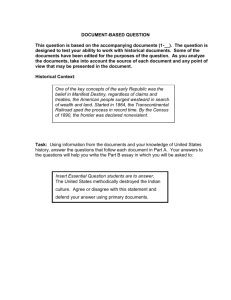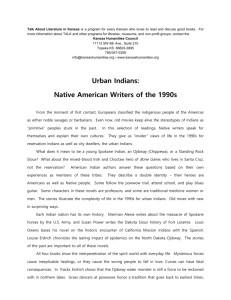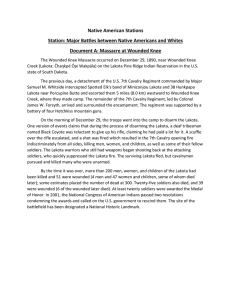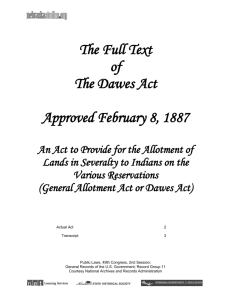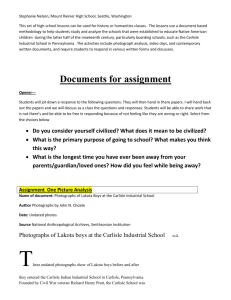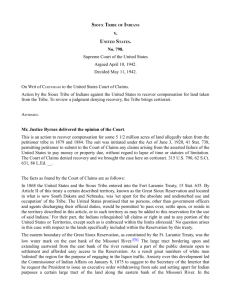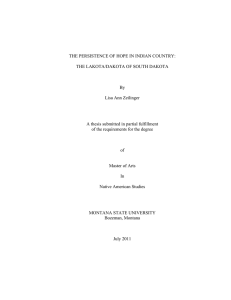Plains Indian
advertisement
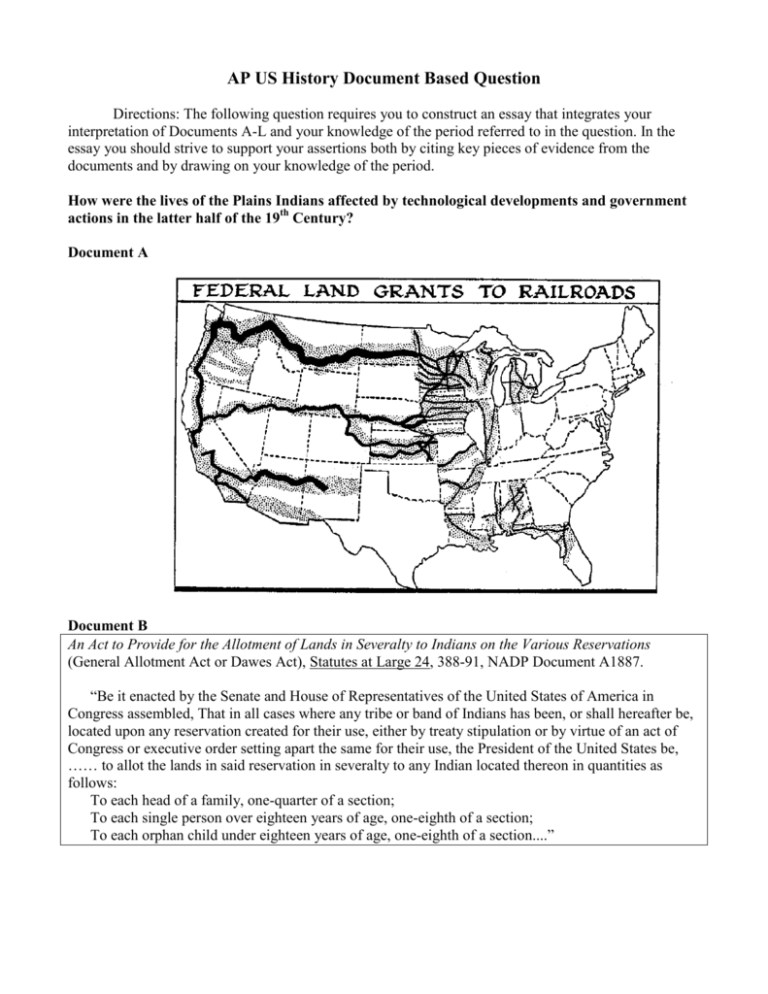
AP US History Document Based Question Directions: The following question requires you to construct an essay that integrates your interpretation of Documents A-L and your knowledge of the period referred to in the question. In the essay you should strive to support your assertions both by citing key pieces of evidence from the documents and by drawing on your knowledge of the period. How were the lives of the Plains Indians affected by technological developments and government actions in the latter half of the 19th Century? Document A Document B An Act to Provide for the Allotment of Lands in Severalty to Indians on the Various Reservations (General Allotment Act or Dawes Act), Statutes at Large 24, 388-91, NADP Document A1887. “Be it enacted by the Senate and House of Representatives of the United States of America in Congress assembled, That in all cases where any tribe or band of Indians has been, or shall hereafter be, located upon any reservation created for their use, either by treaty stipulation or by virtue of an act of Congress or executive order setting apart the same for their use, the President of the United States be, …… to allot the lands in said reservation in severalty to any Indian located thereon in quantities as follows: To each head of a family, one-quarter of a section; To each single person over eighteen years of age, one-eighth of a section; To each orphan child under eighteen years of age, one-eighth of a section....” Document C San Carlos Apache Reservation 1887 1904 Area (acres) 2,528,000 1,834,240 Tillable land 12,000 Cultivated land 1,900 1,285 Grains (bshls) 13,389 10,053 Vegetables (bshls) 525 2,111 Cattle 3,869 280 Document D Lane to Commissioner, 20 August 1888, in United States, Interior Department, Report of the Secretary of the Interior; Being Part of the Message and Documents Communicated to the Two Houses of Congress at the Beginning of the Second Session of the Fiftieth Congress, vol. 2 (Washington: Government Printing Office, 1888), NADP Document D138. CONDITION OF THE INDIANS, HABITS, ETC. “With a few exceptions all live in frame houses, all wear citizens' clothes, most them speak English, nearly all between ten and twenty-five years of age can read and write. In their habits they are reasonably industrious, sober, peaceable, and in the main, moral. The old-fashioned customs are dying out among them gradually. A great many of the old ones still hold to their ideas of superstition and their Indian doctors, but while they patronize their doctors they don't seem to have much confidence in them beyond their supposed services to the sick, and even then they do not entirely ignore the white physician. In their recreations the customs of civilization predominate, they are good-natured, fond of joking and of music, and in favor of education…. The educational facilities of this agency consist of one boarding-school for boys and girls capable of accommodating comfortably 65 scholars. School was taught continuously from September 19 to June 30, with an average attendance of about 52 scholars. More could have been procured, but they were not considered desirable on account of health or morals, my idea being that it were better to have fewer in number and better in discipline and health; and, in consequence, better advancement was made in studies both educational and industrial than had been made the year previous.” Document E Harper's Weekly, August 16, 1890 Volume 34. “If the white man wants to live in peace with the Indian....we can live in peace. There need be no trouble. Treat all men alike.... give them all the same law. Give them all an even chance to live and grow. You might as well expect the rivers to run backward as that any man who is born a free man should be contented when penned up and denied liberty to go where he pleases. We only ask an even chance to live as other men live. We ask to be recognized as men. Let me be a free man.... free to travel.... free to stop....free to work...free to choose my own teachers.... free to follow the religion of my Fathers.... free to think and talk and act for myself.” Chief Joseph, Nez Perce, 1887. Document F THE WHITE CALF BUFFALO WOMAN by CaMary Wynne The Buffalo Woman of the Lakota Souix Document G Ketcham to Commissioner of Indian Affairs, June 1918, in United States, Department of the Interior, Reports of the Department of the Interior for the Fiscal Year Ended June 30, 1918, vol. 2 (Washington: Government Printing Office, 1919), 413, NADP Document D147. “The Indian School is under the jurisdiction of the superintendent of the Reservation. The Government farmer, who is a member of the tribe, is the sole representative of the Indian Office at this place. Practically all that he has to do is give out aid to several old, dependent Indians. The best of order prevails here, so that no supervision is needed. If the rank and file of the population are considered, this is the most thoroughly civilized Indian jurisdiction I ever have visited. Its one need is proper medical attention, and I would suggest that the Indian Office make an arrangement for a contract physician for this place.” Document H Thomas Nast Cartoon, 1885 Document I http://www.thewildwest.org/native american/wisdom/Lakota.html “Praise, flattery, exaggerated manners, and fine high-sounding words were no part of the Lakota politeness. Excessive manners were put down as insincere, and the constant talker was considered rude and thoughtless. Conversation was never begun at once, or in a hurried manner. No one was quick with a question, no matter how important, and no one was pressed for an answer. A pause giving time for thought was the truly courteous way of beginning and conducting a conversation.” - Chief Luther Standing Bear, Teton Lakota (Sioux) “The true Indian sets no price upon either his property of his labor. His generosity is limited only by his strength and ability. He regards it as an honor to be selected for a difficult or dangerous service, and would think it shameful to ask for any reward, saying rather: "Let the person I serve express thanks according to his own bringing up and his sense of honor.” - Charles Alexander Eastman, Santee Lakota (Sioux) Document J Thomas Bailey, The American Pageant, 3rd Edition Document K On January 3, 1891 (after the Wounded Knee massacre) The Aberdeen Saturday Pioneer published another editorial: “The peculiar policy of the government in employing so weak and vacillating a person as General Miles to look after the uneasy Indians, has resulted in a terrible loss of blood to our soldiers, and a battle which, at best, is a disgrace to the war department. There has been plenty of time for prompt and decisive measures, the employment of which would have prevented this disaster. The PIONEER has before declared that our only safety depends upon the total extermination of the Indians. Having wronged them for centuries we had better, in order to protect our civilization, follow it up by one more wrong and wipe these untamed and untamable creatures from the face of the earth. In this lies safety for our settlers and the soldiers who are under incompetent commands. Otherwise, we may expect future years to be as full of trouble with the redskins as those have been in the past. An eastern contemporary, with a grain of wisdom in its wit, says that when the whites win a fight, it is a victory, and when the Indians win it, it is a massacre.” Document L The following quotes were printed in The Aberdeen Saturday Pioneer, a weekly newspaper published in Aberdeen, South Dakota. The first was published immediately after Sitting Bull's assassination by Indian Police Dec. 15, 1890. “Sitting Bull, most renowned Sioux of modern history, is dead. The proud spirit of the original owners of these vast prairies inherited through centuries of fierce and bloody wars for their possession, lingered last in the bosom of Sitting Bull. With his fall the nobility of the Redskin is extinguished, and what few are left are a pack of whining curs who lick the hand that smites them. The Whites, by law of conquest, by justice of civilization, are masters of the American continent, and the best safety of the frontier settlements will be secured by the total annihilation of the few remaining Indians. Why not annihilation? Their glory has fled, their spirit broken, their manhood effaced; better that they die than live the miserable wretches that they are. History would forget these latter despicable beings, and speak, in later ages of the glory of these grand Kings of forest and plain that Cooper loved to heroism.”








